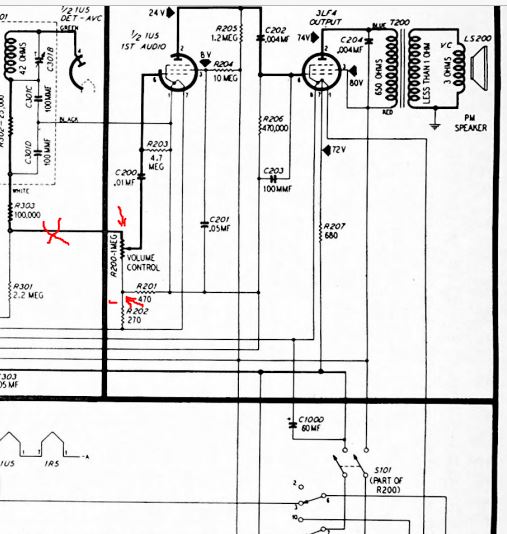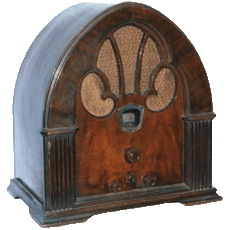01-17-2025, 10:11 AM
Consider, at the very least, replacing the caps involved with the audio stages, especially C200, C201, C202 and C204. In addition, the B+ and Cathode Bypass caps are important. These are C1000D, C303, C401 thru 403, C405 thru 407. Failure of any of these caps could cause bias or oscillation issues.
Did you substitute the speaker or merely place it in parallel with the existing speaker? A speaker with an "off center voice coil will sound "raspy" and will get worse as it gets louder.
I often recommend the installation of an Aux input to increase the usefulness of the radio but also to "divide and conquer" as to whether the issue is with the RF / IF / Detector section or the AF Amp section. However, I do not usually do this on AC-DC AA5s and especially not on Battery / Line Power portables for 2 reasons:
1. The power output on these portable sets is only about 0.2W
2. This is a "Warm Chassis" set that has a rather high leakage from chassis to ground depending on power
cord polarity and status of the on-off switch.
However, temporarily disconnecting the radio signal from the volume control and injecting an audio signal from an external source (MP3 Player on its own batteries would be safest) way to do so.
Attached below is a section of the diagram. Cut at the "X" and inject at the arrows, with the "hot"(tip) of the output on the pot side of the X and the ground (shield) of the MP3 to the junction of the pot, R201 and R202. Use an MP3 with an all plastic case or set the MP3 before powering up the radio.

Hope this helps.
Did you substitute the speaker or merely place it in parallel with the existing speaker? A speaker with an "off center voice coil will sound "raspy" and will get worse as it gets louder.
I often recommend the installation of an Aux input to increase the usefulness of the radio but also to "divide and conquer" as to whether the issue is with the RF / IF / Detector section or the AF Amp section. However, I do not usually do this on AC-DC AA5s and especially not on Battery / Line Power portables for 2 reasons:
1. The power output on these portable sets is only about 0.2W
2. This is a "Warm Chassis" set that has a rather high leakage from chassis to ground depending on power
cord polarity and status of the on-off switch.
However, temporarily disconnecting the radio signal from the volume control and injecting an audio signal from an external source (MP3 Player on its own batteries would be safest) way to do so.
Attached below is a section of the diagram. Cut at the "X" and inject at the arrows, with the "hot"(tip) of the output on the pot side of the X and the ground (shield) of the MP3 to the junction of the pot, R201 and R202. Use an MP3 with an all plastic case or set the MP3 before powering up the radio.
Hope this helps.
"Do Justly, love Mercy and walk humbly with your God"- Micah 6:8
"Let us begin to do good"- St. Francis
Best Regards,
MrFixr55



![[-] [-]](https://philcoradio.com/phorum/images/bootbb/collapse.png)


